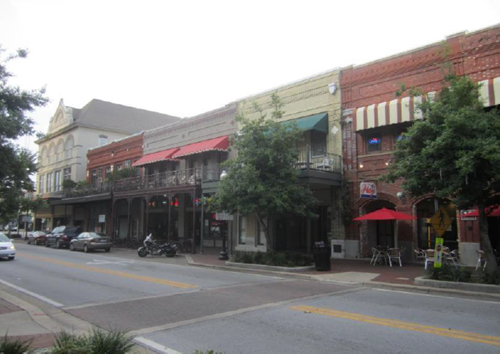
For Immediate Release
Friday, July 8, 2016
Contact:
Secretary Detzner Announces Recent Designation of National Register Historic Districts in Jacksonville and Pensacola
Secretary of State Ken Detzner announced today that the Downtown Jacksonville Historic District and Pensacola’s Palafox Historic District were recently listed on the National Park Service’s National Register of Historic Places.
“I am pleased to announce the recent listing of these large urban historic districts on the National Register of Historic Places,” said Secretary Detzner. “These districts provide a welcoming “sense of place” and unique authenticity that both residents and visitors enjoy. With their designation, and the support of Federal Historic Preservation Tax incentives, eligible properties may be adapted for retail and commercial purposes, enriching and expanding the heritage tourism experience so vital in our state.”
The Downtown Jacksonville Historic District encompasses approximately 56 blocks (158 acres) and includes 176 contributing historic buildings, one contributing site, two contributing objects and 19 buildings previously listed on the National Register of Historic Places. The district is bounded by East and West Beaver Street on the north, Catherine Street on the east, Independent Drive and Courthouse Drive on the south, and North Pearl Street on the west. The period of significance is 1901 to 1965, and relates to the development of downtown Jacksonville, following the Great Fire of May 3, 1901. A number of historic buildings were designed and built by notable architects and builders who flocked to Jacksonville after the fire. In addition to commercial architecture, the downtown area includes many religious buildings. Architectural styles within the district include Prairie and Chicago School, Colonial Revival, Mediterranean Revival, Neoclassical Revival, Beaux Arts, Renaissance Revival, Gothic Revival, Romanesque Revival, Modernist, and Frame and Masonry Vernacular.

West Bay Street, Jacksonville
The Palafox Historic District in Pensacola contains 94 contributing historic properties and is roughly bounded on the north by East and West Wright Streets, on the west by Spring Street and Baylen Street, on the south by Zarragossa Street, and on the east by Tarragona Street and South Jefferson Street. The Palafox District spans three periods of significance, beginning in 1880 and ending in 1965. Over half of the historic buildings in the district date from 1880 to 1914, when Pensacola was a thriving seaport made prosperous by the lumber and fishing industries. Thirty-two buildings within the district were built between 1915 and 1945, mainly to support the U.S. military services stationed around Pensacola between World War I and World War II. The Palafox Historic District is near the earlier Pensacola Historic District, already listed on the National Register for its period of significance, 1800 to 1890.

South Palafox Street, Pensacola
For more information about the National Register of Historic Places program administered by the National Park Service, visit nps.gov/nr. For more information about the Federal Historic Preservation Tax Incentives program, visit nps.gov/tps/tax-incentives.htm.
# # #
About The National Register of Historic Places
The National Register of Historic Places is a list maintained by the National Park Service which includes historical or archaeological properties including buildings, structures, sites, objects, and districts, that are considered worthy of preservation because of their local, statewide and/or national significance. Nominations for properties in Florida are submitted to the National Park Service through the Florida Department of State’s Division of Historical Resources. Florida has over 1,700 listings on the National Register, including 291 historical districts and 172 archaeological sites. There are more than 50,000 sites contributing to the National Register in Florida. For more information, visit flheritage.com/preservation/national-register.
About Federal Historic Preservation Tax Incentives
The Federal Historic Preservation Tax Incentives program encourages private sector investment for rehabilitation and re-use of historic buildings. The program creates jobs and nationally has leveraged over $78 billion in private investment to preserve over 41,250 historic properties since 1976. In Florida, 251 historic rehabilitation projects have been certified between 1995 and 2015, yielding investments of $988.9 million. The program is jointly administered by the Internal Revenue Service and the National Park Service in partnership with State Historic Preservation Offices (SHPOs). In Florida, the SHPO is the Director of the Division of Historical Resources at the Florida Department of State.The Florida SHPO is the first point of contact for Florida projects seeking tax credits. To learn more, visit flheritage.com/preservation/architectural-preservation-services/rehabilitation-tax-credit
About The Bureau of Historic Preservation
The Florida Department of State’s Bureau of Historic Preservation (BHP) conducts historic preservation programs aimed at identifying, evaluating, preserving and interpreting the historic and cultural resources of the state. The Bureau manages the Florida Main Street Program, and under federal and state laws, oversees the National Register of Historic Places program for Florida, maintains an inventory of the state's historical resources in the Florida Master Site File, assists applicants in federal tax benefit and local government ad valorem tax relief programs for historic buildings, and reviews the impact that development projects may have on significant historic resources. For more information, visit flheritage.com/preservation.
